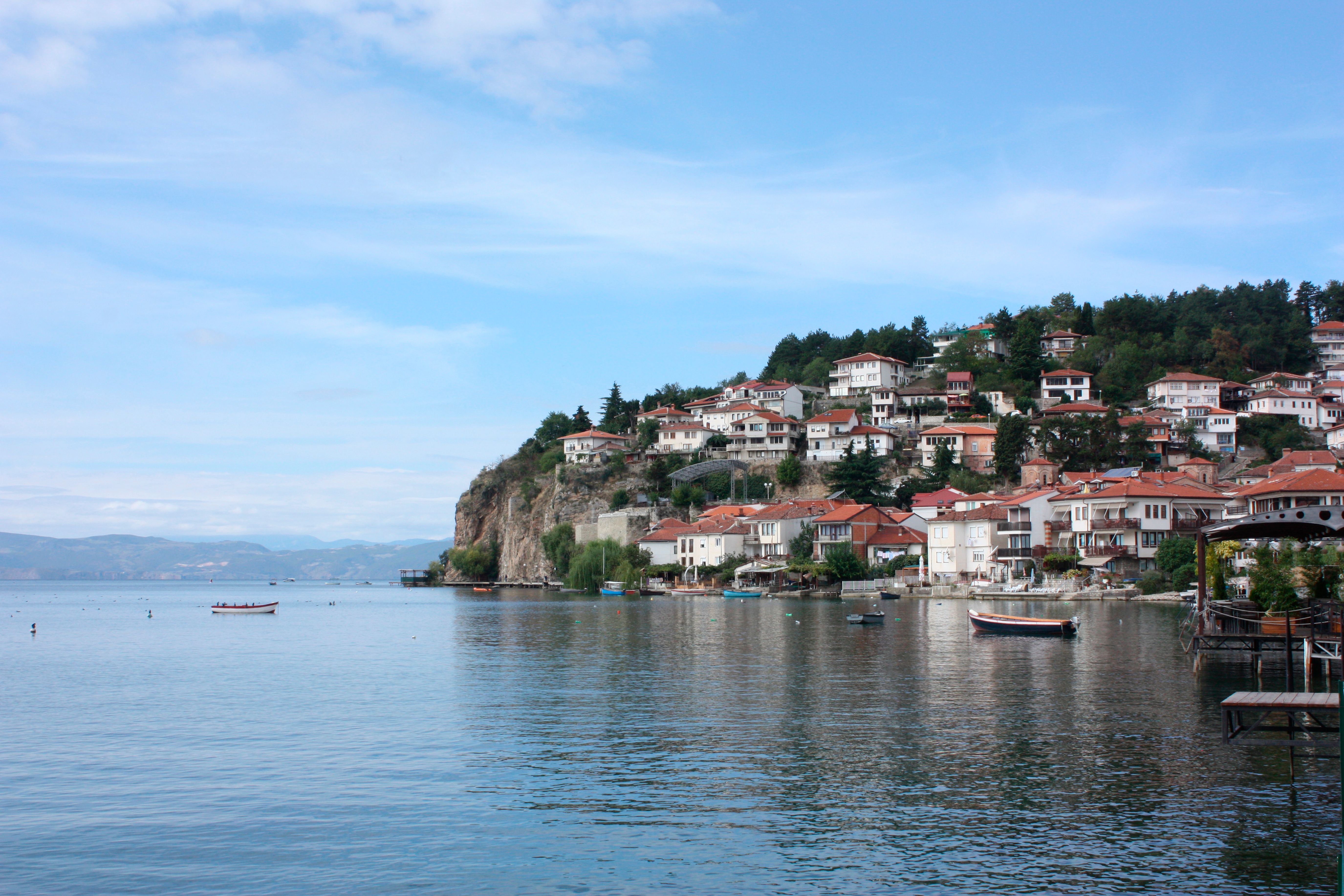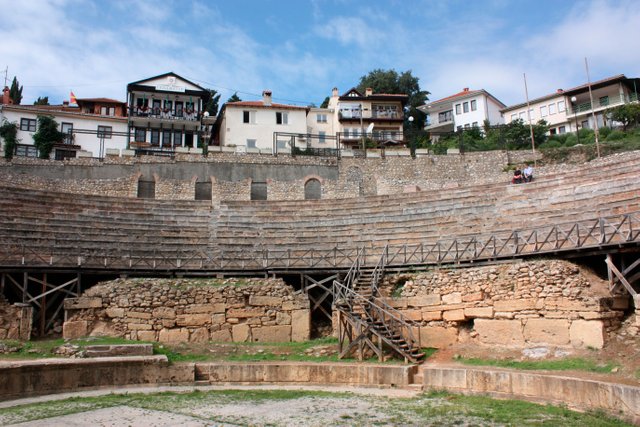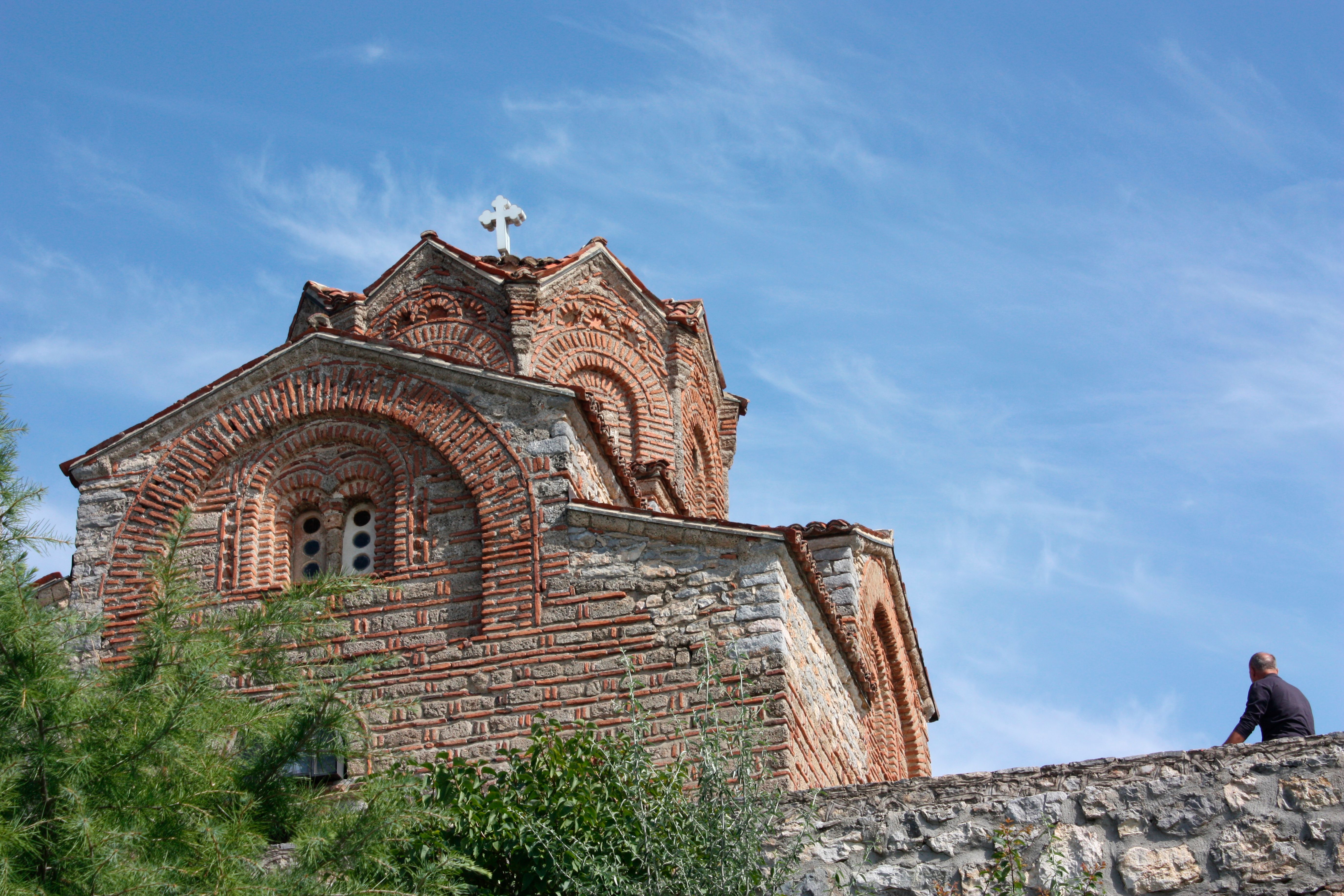
Hello Steemians:
The climate of Lake Ohrid is almost Mediterranean, which is why the weather in Ohrid town when I arrived was sunny and warm whereas Skopje, on the other side of the mountains, was cloudy and cool.
The lake is clear to a depth of roughly 12 metres and its water comes mainly from another lake, Prespa, higher up in the mountains. Lake Ohrid is almost 18 miles long and has a deepest point of 286 metres. The lake was declared a UNESCO World Heritage Site in 1979. Around 200 of the species of plants and aquatic creatures found here are endemic to the area. Lake Ohrid is divided between Macedonia (2/3) and Albania (1/3). The border between the two countries can be seen on the opposite side of the lake.
Evidence has been found of a people living over the lake - around 30 metres from the shore - approximately 7000 years ago. These people carved animal bones for use as utensils and were able to drive wooden piles into the bed of the lake securely enough for their dwellings to be safe.
Ohrid town has many beautiful sights including the classical amphitheatre, Car Samoil's Castle, Sveta Sofija Cathedral, and the most photographed building in Macedonia, the Church of Sveti Jovan at Kaneo, an absolute gem of a small church situated above the lake with great views in all directions.

The classical amphitheatre was lost for many centuries and was only rediscovered when some houses were being built in the early 1980s. This amphitheatre was constructed in 200 BC and is the only known Hellenistic theatre in Macedonia. It seems as though the Romans removed some of the lower tiers of seating to stage gladiatorial contests including the killing of Christians. The local population disliked the killings and covered up the amphitheatre once the Roman Empire had fallen. This action probably led to the amphitheatre being so well preserved. Today, it’s used as one of the settings for the Ohrid Summer Festival and the famous Bolshoi Ballet have performed there in the past.
As I walked around Ohrid I remembered what I had read about a man called St Clement of Ohrid, after whom the main Orthodox church in Skopje is named. Clement is the patron saint of the Republic of Macedonia, of the city of Ohrid, and of the Macedonian Orthodox Church. Clement was the most prominent disciple of Saints Cyril and Methodius and is often associated with the creation of the Glagolitic and Cyrillic scripts. He was the founder of the Ohrid Literary School (which nowadays may be regarded as a university) and is regarded as a patron of education and language by some Slavic nations. The reason for this is that after the adoption of Christianity in 865, religious ceremonies in Bulgaria were conducted in Greek by Byzantine Empire clergy. Fearing growing Byzantine influence, Boris I of Bulgaria viewed the adoption of the Old Slavonic language as the best way to preserve the political independence and stability of Bulgaria. Boris established two literary academies where theology was to be taught in the Slavonic language and St Clement was placed in charge of one of these.
The authorities in Ohrid are building a new university and during the construction many small churches have been found, which require careful research. The previous university was Europe's, and possibly the world's (depending on your definition of what constitutes a university), oldest. In 1000 AD Ohrid was the episcopal base for an Orthodox church whose boundaries were the Danube River, Malta, Odesa, and Greece. This is a huge area even today and shows the importance of Ohrid in those times.
Car Samoil’s Castle is named after the Bulgarian Tsar Samuel, who ruled the Bulgarian Empire from 997 to 1014. The fortress dates from his reign and the ramparts on the high walls offer wonderful views in all directions. This fortification couldn’t prevent the Byzantine Empire defeating the Bulgarian forces at the beginning of the 11th Century, and then the Ottomans took over the area from the Byzantines in the 14th Century. The real low point for Ohrid though came in 1767, when due to Greek intrigue - still a grievance for Macedonians and for Bulgarians - the archbishopric of Ohrid was abolished. Happily, the archbishopric was restored in 1958 and continues to this day as the Macedonian Orthodox
Church’s highest office.
Sveta Sofija Cathedral is around a thousand years old and contains elaborate Byzantine frescoes. This cathedral has excellent acoustics and is used for concerts during the Ohrid Summer Festival as is an area in the cathedral grounds. However, the prettiest church in Ohrid can be found by the lake and dates from the 13th Century.

The church of Sveti Jovan at Kaneo sits on a promontory above Lake Ohrid, from where you can see most of the lake and a lot of the lakeshore. In one direction can be seen boats, restaurants, and the waterfront of the town of Ohrid, and in the other trees overhang the clear azure waters. It’s a peaceful place and as I sat under a tree and stared into the lake a calmness descended on my mind as the sunlight reflected off the water and patterns played on the stones, rocks, and fish at the bottom. I could just imagine a monk sitting here and finding much spiritual fulfilment from the view I had, because I know that nothing much has changed in this place for hundreds of years, except for the fish. There is a clearness and a cleanness to the light that reminds me of the Greek light found in their Mediterranean islands.